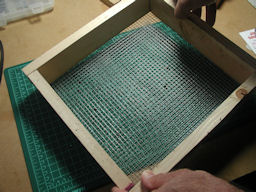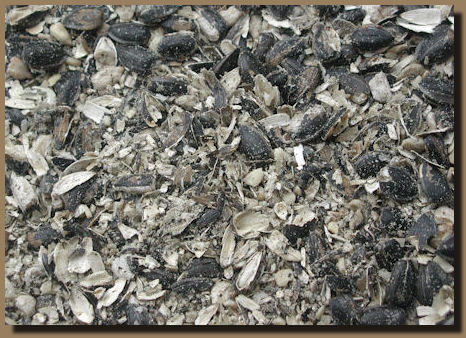NOTE: If you get a warning about this page wanting to run an ActiveX control, it's because of a javascript routine to improve navigation or to put text associated with hyperlinks in the browser Status Bar. I don't do viruses or hacker crap, but it's your choice... You won't miss anything substantive by refusing permission.
Corona Mill Dehuller Attachment - Page 4
EPILOGUE
Basically, not much on this page is relevant to the use of the Corona mill or the dehuller attachment in the hulling of sunflower seeds. Because, as I hope to have made clear earlier, it is the nearest thing to useless for that application.
However, to perhaps save you some time if you are researching the subject and do have access to a quality mill, I'll summarize some of the more relevant information I found.
GRADING AND WINNOWING
Grading the Seeds
The article from the April 1979 issue of Organic Gardening reproduced at this link discusses the entire process of hulling, grading and winnowing sunflower seeds for oil production. Though they mention the Corona, the article obviously is oriented to much higher quality machinery. It includes instructions for both a winnowing box and an oil press.
They state that, to obtain better results, it is necessary to grade the bulk whole seeds by size before dehulling. I'll briefly describe their method:
 Three boxes, approximately one foot square each, are built using wood and 1/4 inch hardware cloth (a metal screen with 1/4 inch mesh, available at any hardware store). I used 1 x 3 whitewood (cheap) and a brad nailer, cutting the lumber into two ten inch and two twelve inches pieces for each box.
Three boxes, approximately one foot square each, are built using wood and 1/4 inch hardware cloth (a metal screen with 1/4 inch mesh, available at any hardware store). I used 1 x 3 whitewood (cheap) and a brad nailer, cutting the lumber into two ten inch and two twelve inches pieces for each box.
The first box uses one layer of cloth, the second has two layers slightly offset, and the third has the second layer of cloth offset more. The intent is to create gradually narrower openings. By sifting the seeds progressively through the three boxes, you hope to end up with four piles of whole seeds graded by size. In actual practice, I found the best that can be hoped for is three different grades. Hardware cloth is not a precision product, so offsetting two layers does not produce consistent openings across the entire surface. One box with one layer of cloth, and a second with two layers offset so that a majority of the openings are half the size, was adequate. A box with "slightly offset" mesh did not produce a grade significantly different in size from their "offset more" box.
I bought a cheap plastic twenty-four inch water heater pan to catch the seeds and spillage during the sifting process. Otherwise, you'll be stepping on sunflower seeds for weeks afterwards.
No amount of grading made any difference in the results obtained with the Corona mill, with or without the dehuller attachment.
Winnowing
Winnowing is the process of separating the nutmeats from the husks, usually using a current of air.
For my purposes--feeding birds--I wouldn't bother. Let them separate out the nutmeats from the husks themselves.
For anyone who feels the need for the seeds to be free of husks and other residue, I refer you to the previously referenced link: the Organic Gardening article for plans of an elaborate winnowing box which uses a vacuum cleaner as an air source.
More simply, you can slowly pour the milled piles into a bowl placed in front of a fan. With the right speed and distance, after a few passes much of the chaff should have been blown away. If you prefer to be totally biodegradable, use the wind.
Adjusting the Mill
The Corona mill is a crude piece of work. You should assemble and inspect it prior to use. If you intend to use it for some type of grain dehulling or cracking barley for homebrew, it may be a good idea to follow the advice of one user on a homebrew forum:
 A very common defect is that the outer grinding plate (the rotating one attached to the auger) is not perpendicular to the axis of rotation. This is easily visible by rotating the crank and watching the variations in clearance between the inner and outer plates. The concern is that this could cause very uneven grinding. What was recommended is eyeballing and adjusting the plate while turning the crank, tacking it in place with JB Kwik until satisfied that it is true, then using JB Weld for permanent fixation. I do not know the safety of using JB Weld in any application where it would be in contact with foodstuffs; you would have to consult the manufacturer.
A very common defect is that the outer grinding plate (the rotating one attached to the auger) is not perpendicular to the axis of rotation. This is easily visible by rotating the crank and watching the variations in clearance between the inner and outer plates. The concern is that this could cause very uneven grinding. What was recommended is eyeballing and adjusting the plate while turning the crank, tacking it in place with JB Kwik until satisfied that it is true, then using JB Weld for permanent fixation. I do not know the safety of using JB Weld in any application where it would be in contact with foodstuffs; you would have to consult the manufacturer.
Adjusting the clearance between the grinding plates is not a simple matter of turning the adjusting screw. Within the body of what they call the toggle bolt (actually, the frame that supports the distal end of the auger) is a channel into which the distal end of the auger assembly inserts. Inside that channel is a steel ball, and a loop of spring wire to keep the ball from falling out. This design works well enough for tightening the screw and reducing the clearance, but for increasing it you must use force to move the entire auger assembly within the body of the mill and force that spring wire deeper into the channel. As the mill is made of brittle cast iron, I suggest very careful application of a rubber mallet to the crank end of the auger assembly.
Conclusion
I'm still searching for a practical and economical way to hull sunflower seeds. The Corona Mill/dehuller attachment combination is not it. If anyone has any suggestions for alternatives, or can tell me where I've gone wrong in any of the preceding, I would appreciate hearing about it. You can reach me at bilagaana@pacbell.net.
Best of luck to you.





All contents copyright bilagaana. All rights reserved. The images are digitally watermarked and may not be copied in any form without the permission of the author. All constructive comments, suggestions, or questions are welcomed.

 Three boxes, approximately one foot square each, are built using wood and 1/4 inch hardware cloth (a metal screen with 1/4 inch mesh, available at any hardware store). I used 1 x 3 whitewood (cheap) and a brad nailer, cutting the lumber into two ten inch and two twelve inches pieces for each box.
Three boxes, approximately one foot square each, are built using wood and 1/4 inch hardware cloth (a metal screen with 1/4 inch mesh, available at any hardware store). I used 1 x 3 whitewood (cheap) and a brad nailer, cutting the lumber into two ten inch and two twelve inches pieces for each box.
 A very common defect is that the outer grinding plate (the rotating one attached to the auger) is not perpendicular to the axis of rotation. This is easily visible by rotating the crank and watching the variations in clearance between the inner and outer plates. The concern is that this could cause very uneven grinding. What was recommended is eyeballing and adjusting the plate while turning the crank, tacking it in place with JB Kwik until satisfied that it is true, then using JB Weld for permanent fixation. I do not know the safety of using JB Weld in any application where it would be in contact with foodstuffs; you would have to consult the manufacturer.
A very common defect is that the outer grinding plate (the rotating one attached to the auger) is not perpendicular to the axis of rotation. This is easily visible by rotating the crank and watching the variations in clearance between the inner and outer plates. The concern is that this could cause very uneven grinding. What was recommended is eyeballing and adjusting the plate while turning the crank, tacking it in place with JB Kwik until satisfied that it is true, then using JB Weld for permanent fixation. I do not know the safety of using JB Weld in any application where it would be in contact with foodstuffs; you would have to consult the manufacturer.


